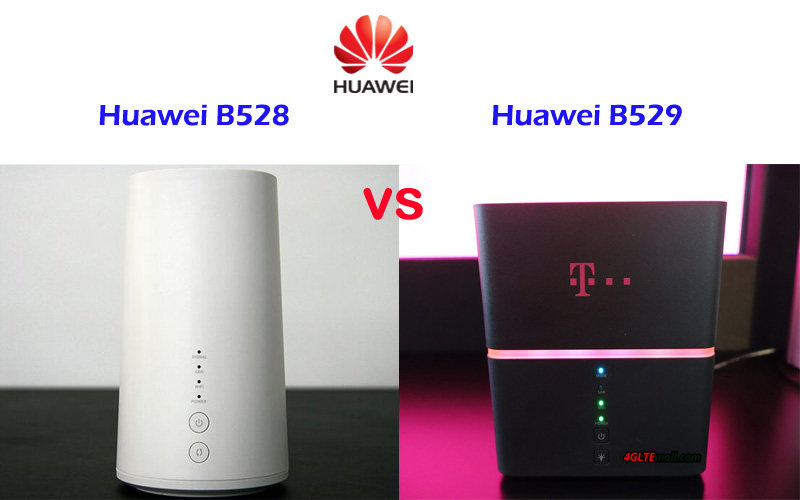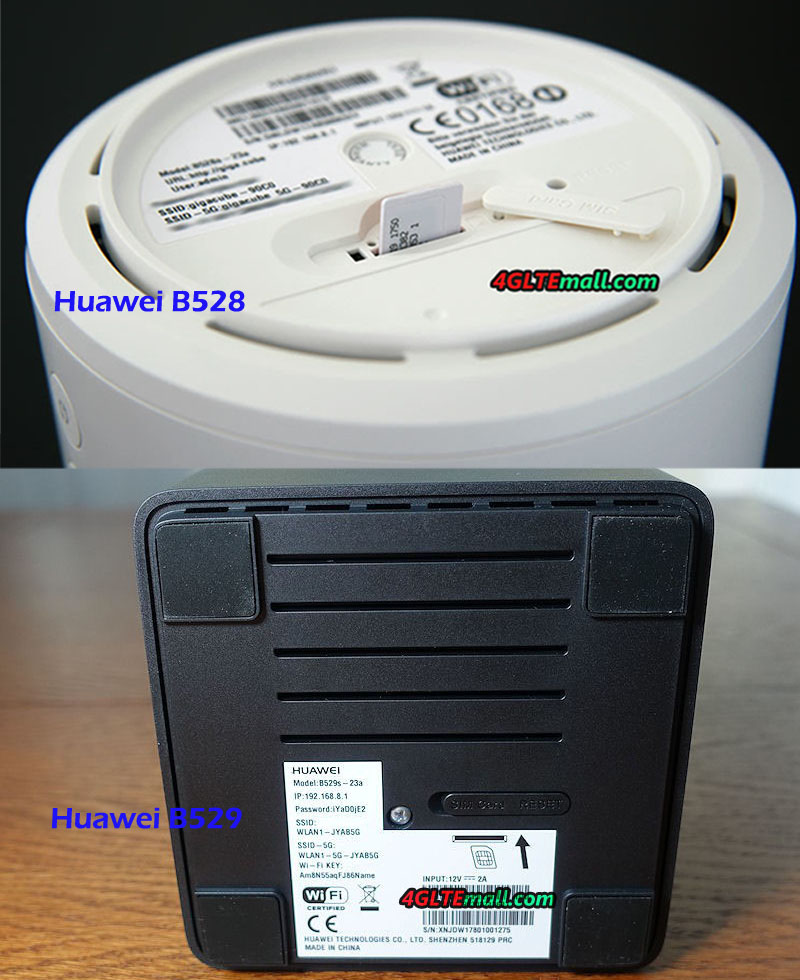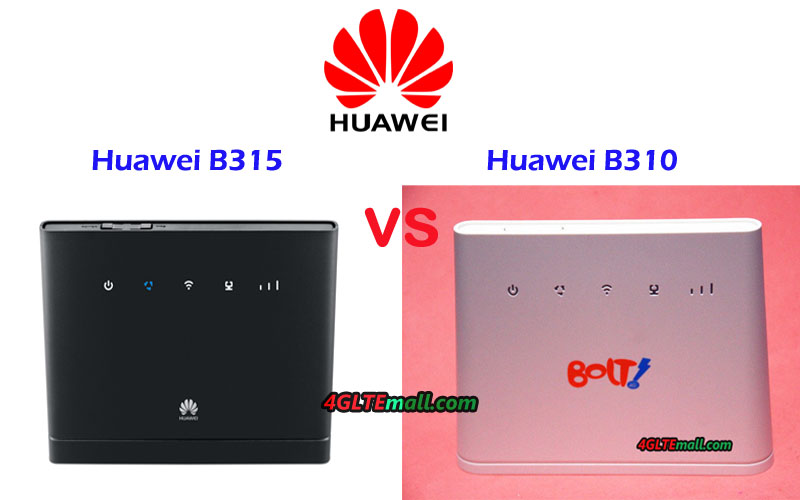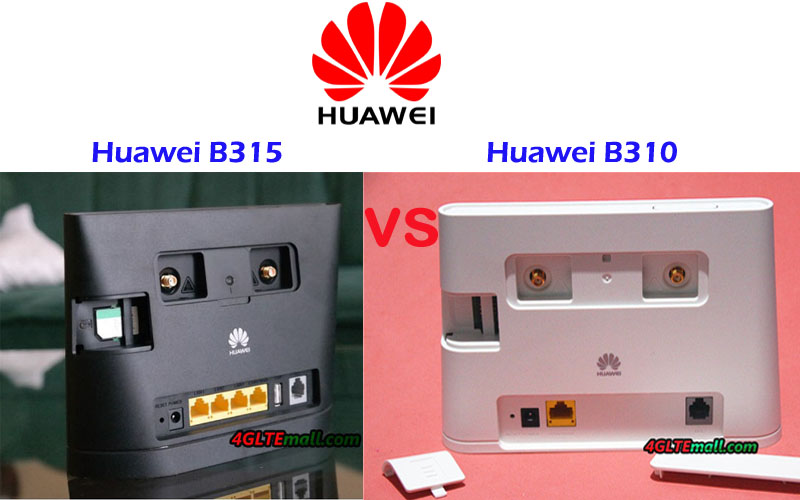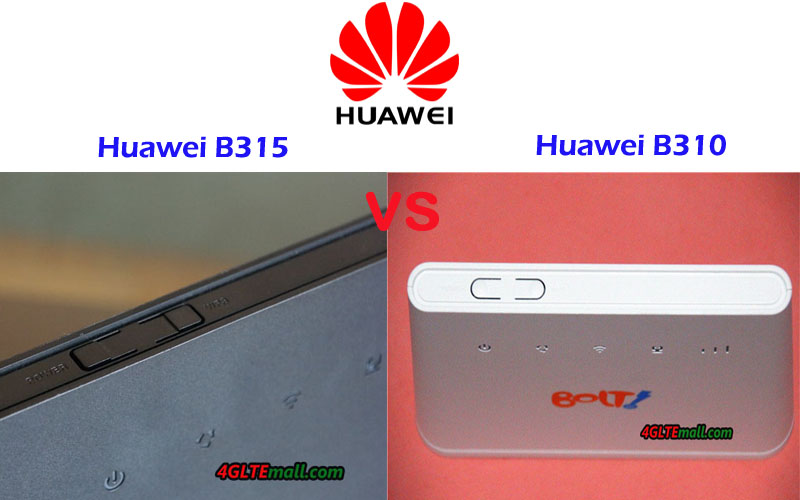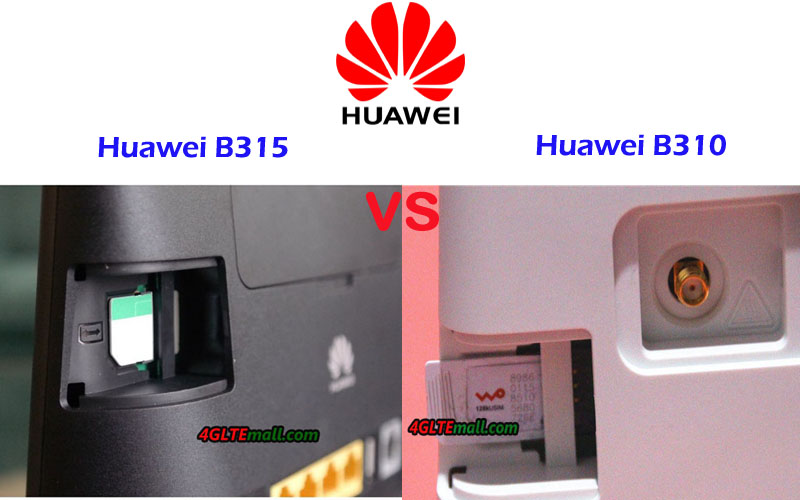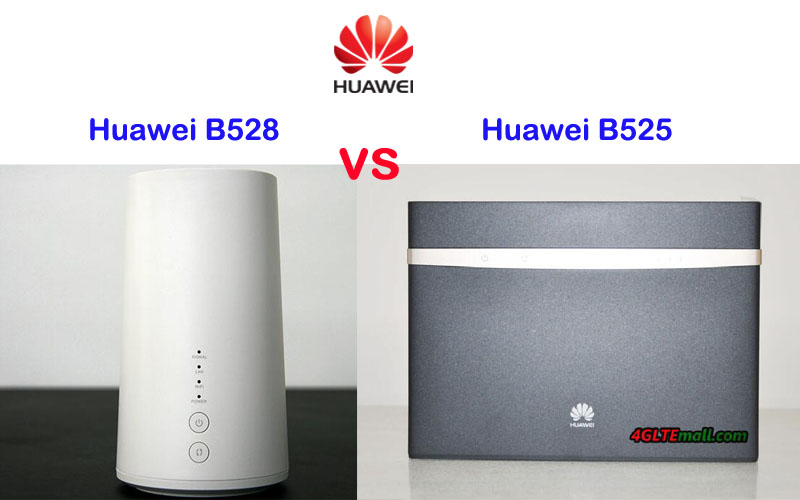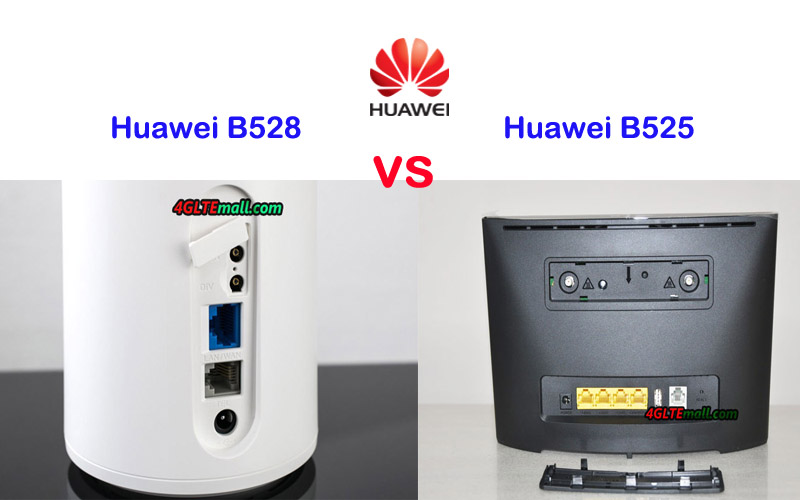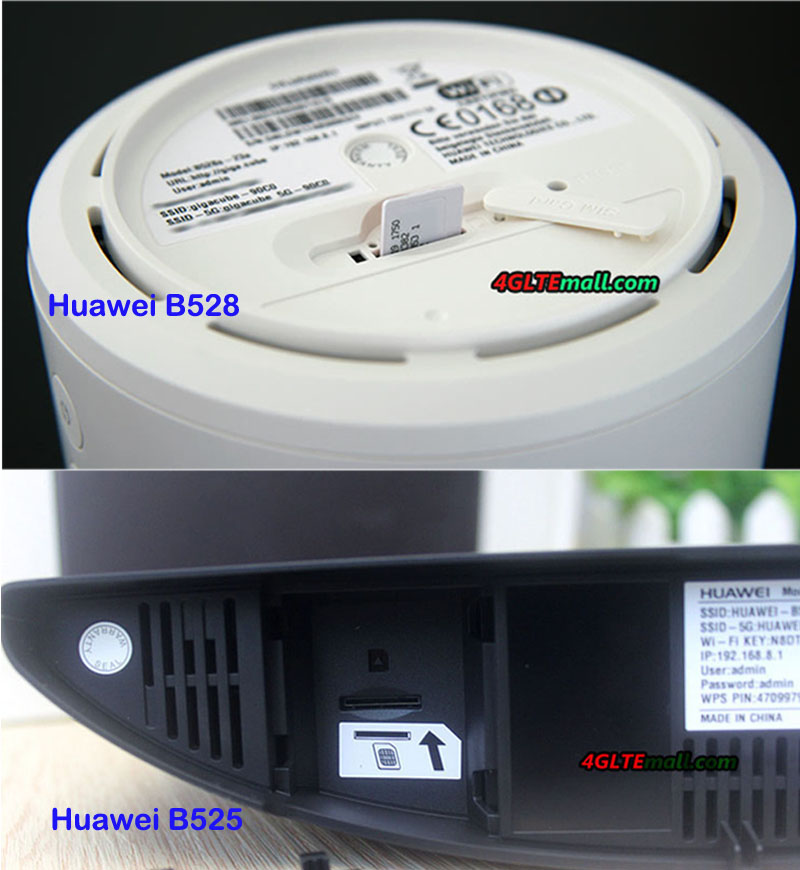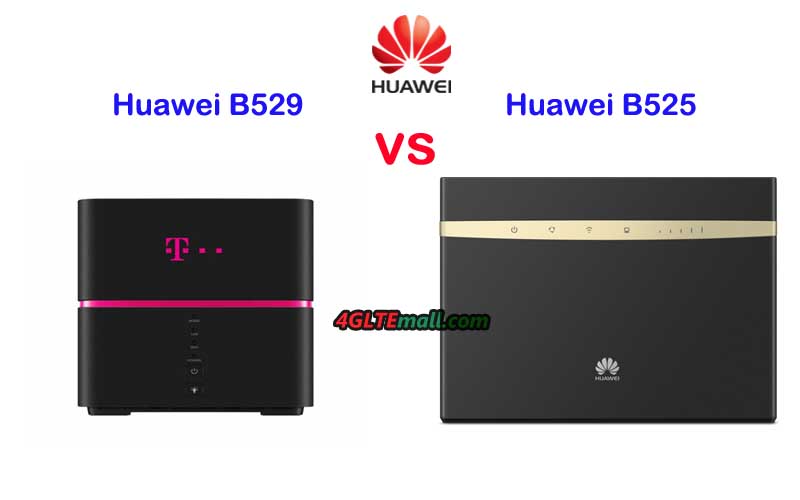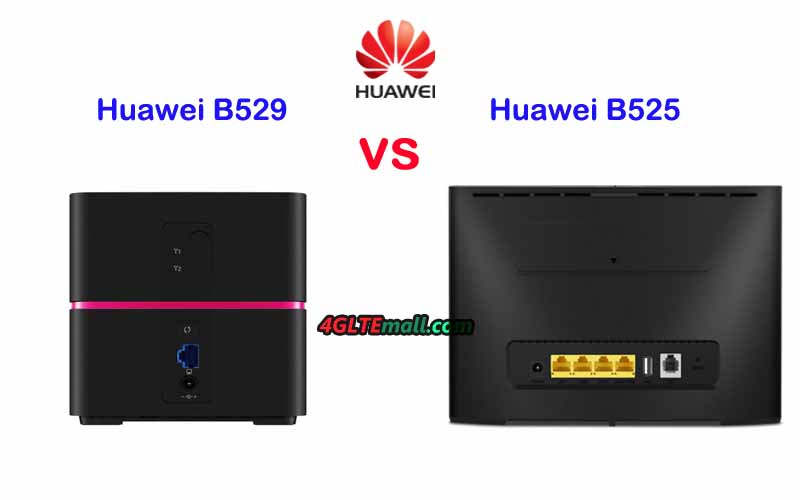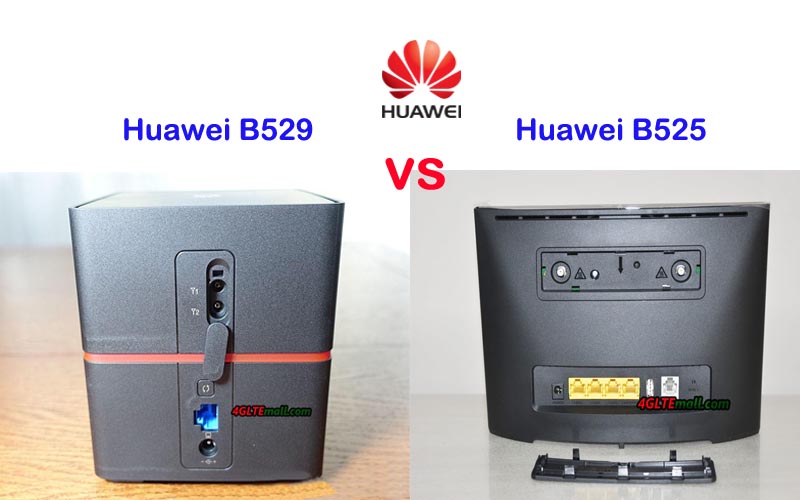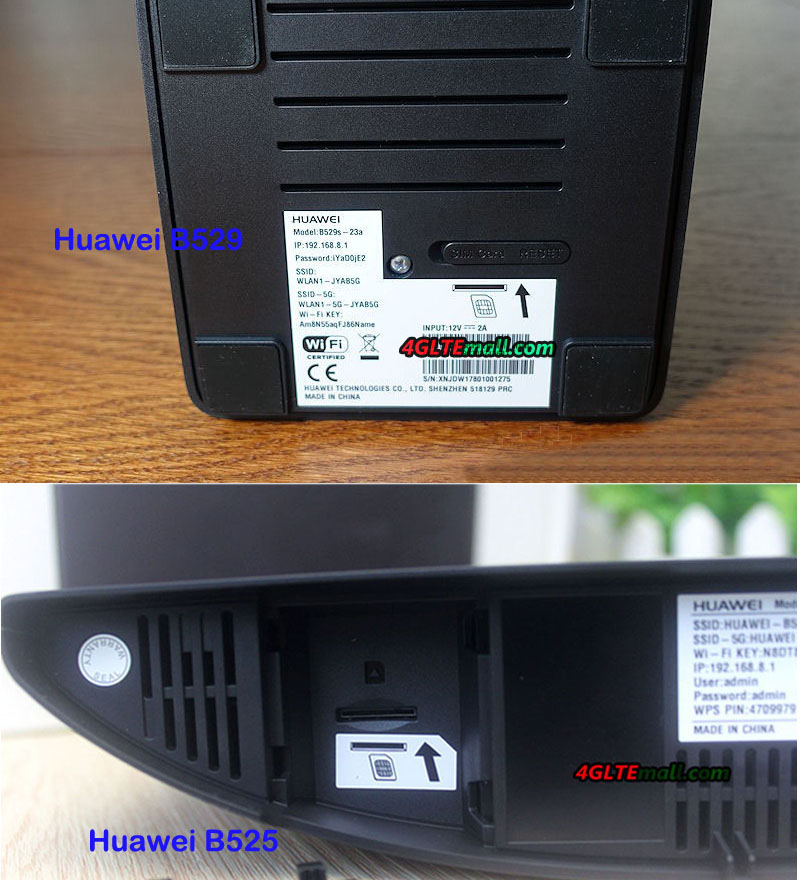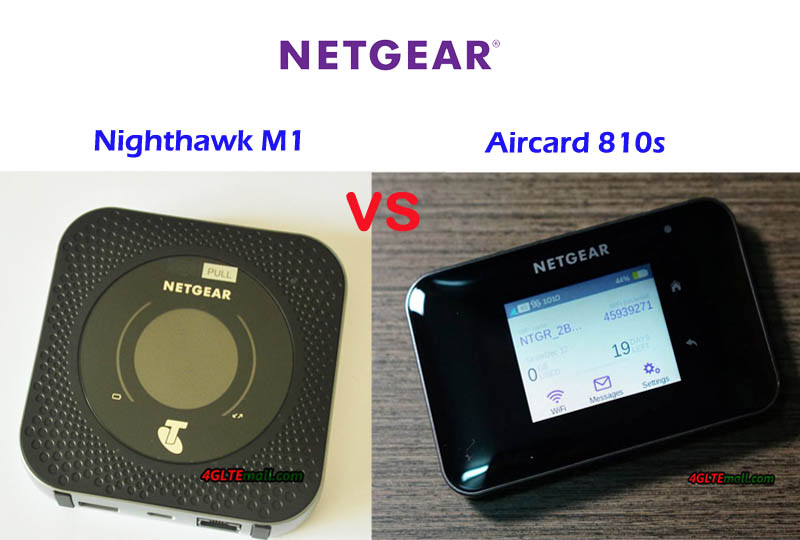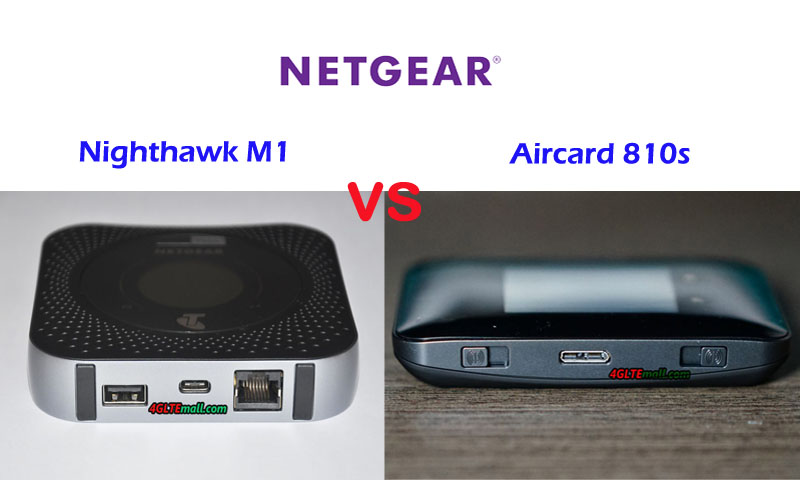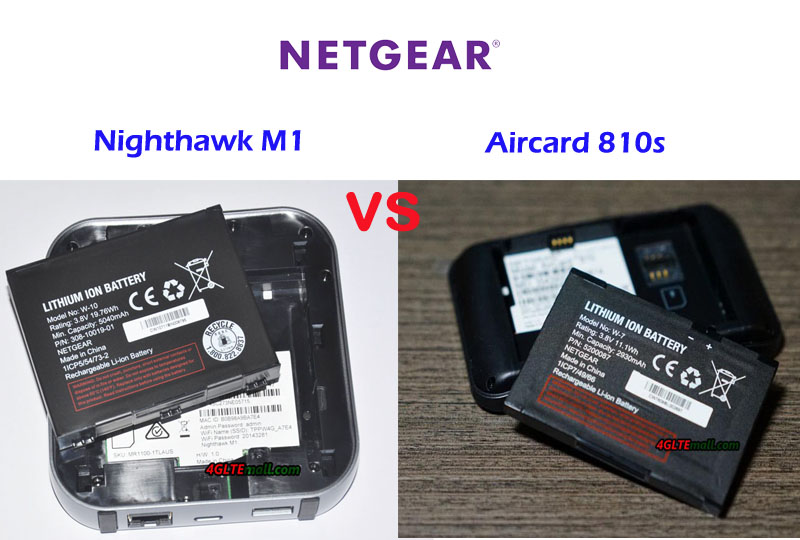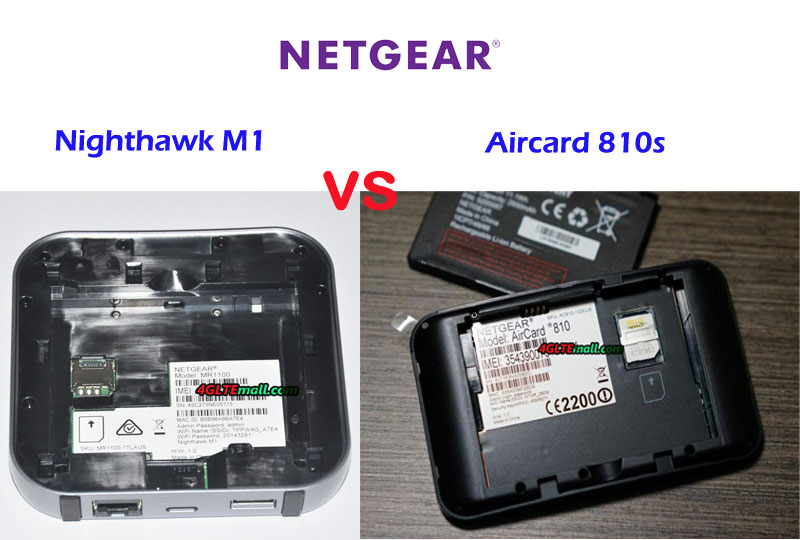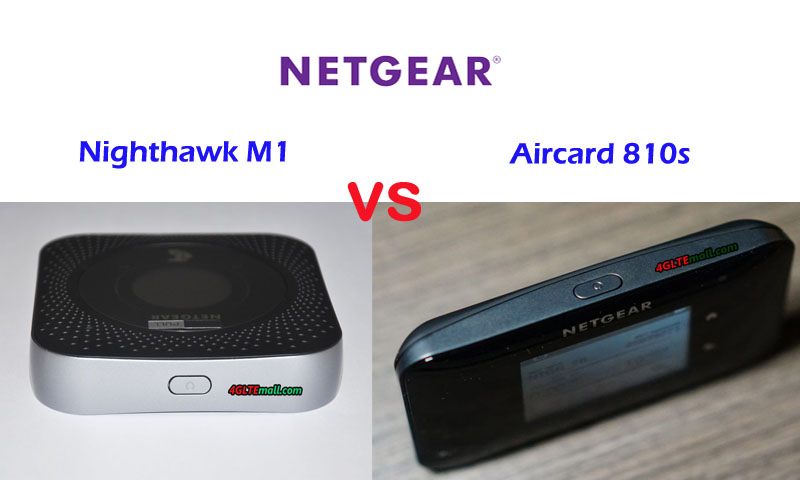mobile broadband
-
Huawei B528 VS Huawei B529 LTE Cube
Since more and more Huawei LTE cubes available in the market, more and more people accept the Huawei Cubes as consumer electronics. Actually, they are still the wireless routers essentially. Huawei assigns the 4G wireless gateway to a new design and combines the workmanship with router functions to make the Cube series product very special but attractive for home use. Huawei B528 and B529 cube are two latest LTE cube for Europe market. Since they are very newly released, many people may don’t know them or don’t know what’s the difference between the Huawei B528 and B529. We will have a review about the two LTE routers and give some buy recommendation for potential users.
Huawei B528 VS B529 Appearance and Interfaces
Frankly speaking, the Huawei B528 LTE Router and B529 Cube are both cool in the design. You may not think they are Huawei wireless 4G Router when you first look at them. The Huawei B528 is in black like a cake and the Huawei B529 looks like a humidifier in white. On the front of Huawei B528, there are indicators for Mode, LAN, WiFi, and Power while the Huawei B529 Cube changes the Mode to Signal. The power button is below the indicators. On the back of Huawei B528, only one Ethernet port is available for LAN. The Huawei B529 has one Gigabit Ethernet port for LAN with one VoIP port. The same feature is the power plug below the Ethernet port. And above the Ethernet port, there are two connectors for external antennas. The connector type is both TS-9. So if you have a Huawei B528 external antenna, you can use it with Huawei B529. What’s more, the two WiFi Cube both uses Micro SIM size and locate the SIM card slot at the bottom of the devices.
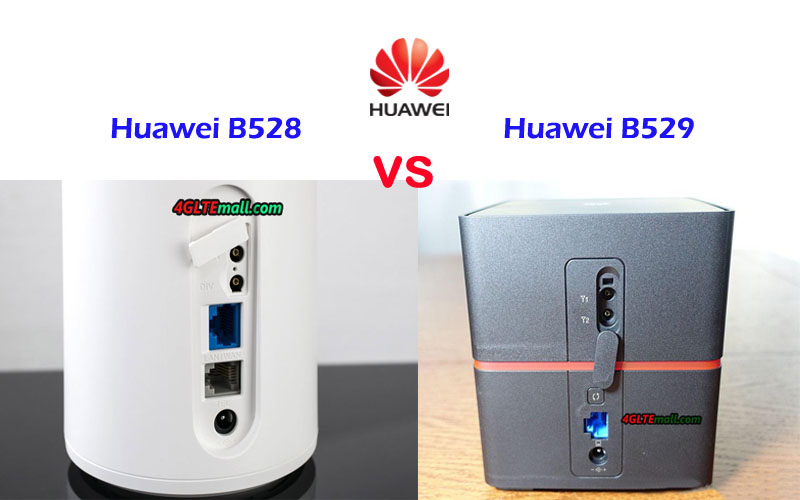
Huawei B529 VS B528 Specs and Variant model
Currently, the Huawei B529 is only available for T-mobile in Europe and get a new name as HomeNet Box. The specific model number is Huawei B529s-23a. Like the B529 Cube, the Huawei B528 is available for the network provider Vodafone and gets a new name Vodafone GigaCube with specific model number Huawei B528s-23a. Unlike the Huawei B618 Cube, they both have an only variant model now. But we are not sure whether there will be more variant models in near future.
From the appearance and interface, you may not get the core difference between the two routers. Let’s have a looks at the Vodafone B528 specs and Huawei B529s-23a specs in the tables below:
Model Huawei B528s-23a Huawei B529s-23a Product type LTE WiFi Cube LTE WiFi Cube Category LTE Cat.6 LTE Cat.6 Chipset HiSilicon Balong 722 HiSilicon LTE Cat6 Chipset Data rates DL 300Mbps/UL 50Mbps DL 300Mbps/UL 50Mbps Supported 4G LTE frequency bands LTE B1, B3, B7, B8, B20, B32, B38 Band 1/3/7/8/20/32/38 WLAN 802.11a/b/g/n/ac, dual-band 2.4GHz & 5GHz 802.11a/b/g/n/ac, dual-band 2.4GHz & 5GHz Max support users 64 users 64 users MIMO 2 x 2 MIMO 2 x 2 MIMO Connector for external antenna Two, TS-9 jacks Two, TS-9 jacks Buy Antenna Huawei B528 External Antenna Huawei B529 External antenna App management Huawei Hilink APP Huawei Hilink APP SIM type Micro SIM Micro SIM Battery NO Yes, non-removable 3000mAh battery Dimensions 105 mm x 90mm x 181 mm 120 x 120 x 125mm Interfaces * 1 x power adapter port * 1 x LAN port(RJ 45)* 1 x RJ11 (VoIP)* Two external LTE antenna ports (TS-9) * One micro-SIM card slot * 1 x power adapter port * 1 x LAN port(RJ 45) * Two external LTE antenna ports (TS-9) * One micro-SIM card slot Datasheet Huawei B528 Datasheet Huawei B529 Datasheet User Manual Huawei B528 Manual Huawei B529 Manual Other features IPv4 /IPv6 dual stack DHCP Server, DNS RELAY and NAT Reviews Huawei B528s-23a Review Huawei B529 Review Price/USD 399.00USD 299.00 Conclusion
The Huawei B528s-23a and HomeNet Box B529s-23a are both LTE Category 6 router, which could support peak download speed to 300mbps and upload speed. They could both support maximum users up to 64 devices. They support even same LTE frequency bands. The only difference is on the Huawei B529 has one more VoIP port than B528. So if you would buy one home router between the two, you would consider the interface first. If you don’t use the VoIP, just take the preferred appearance and make the decision. Per our test, the two routers could support fast internet connection in the real network.
PR -
Huawei B315 VS Huawei B310 LTE CPE Difference
As the successor to Huawei B593 LTE Cat.3 CPE, Huawei presented two similar LTE routers Huawei B310 and B315 LTE CPE to the public. Those who want to buy a home router or want to change 3G routers to 4G wireless routers, may ask what the difference is between the Huawei B310 and B315 and which one is better to use? In this article, we will compare the Huawei B315 and B310 appearance, interfaces, specs, variant models, price and other features etc…You may get the answer finally after reading this blog.
LTE CPE B310 VS B315 Appearance and Interfaces
Huawei B310 and B315 are both typical stationary router like Huawei B593 Router, but the shape has a little difference. They both have four LED indicators on the front for Power, Mode, WiFi, Signal, and LAN. Huawei Logo is on the front in the middle. On the back, usually, there are 4 LAN ports(one for WAN/LAN), but some variant models of the Huawei B310 or B315 may reduce the LAN ports to 2 or 1. It depends. Some models may also have the telephone port or USB.2.0 port. So if you are looking for a router with multiple interfaces for Ethernet, you must take care of this. The LAN ports may not be enough for standard four. And the telephone port and USB 2.0 port may be missing.
LTE CPE B315 VS B310 Specs and Variant models
From the appearance, you may be still unable to identify the real difference. We have to look at the Specifications for Huawei B315 and B310 to see the core content of the two routers. As you may know, there are many variant models available to meet various LTE frequency bands from different network providers. Currently, the LTE CPE B310 has four variant models: B310s-927, B310As-852, B310s-22, B310s-518. The Huawei B315 also has four variant models: B315s-22, B315s-607, B315s-608, B315s-936. As we said, the variant models support different LTE frequency bands and have different Ethernet ports and interfaces. Below you will see the details about Huawei B310 specs and Huawei B315 specs:
Model Huawei LTE CPE B315 Huawei LTE CPE B310 Product type LTE WiFi Router LTE WiFi Router Category LTE Cat.4 LTE Cat.4 Chipset Hisilicon Balong Hisilicon Balong Data rates DL 150Mbps/UL 50Mbps DL 150Mbps/UL 50Mbps Supported 4G LTE frequency bands * Huawei B315s-22: 4G LTE B1/B3/B7/B8/B20/B38 * Huawei B315s-607: 4G Band 1/3/7/8/28/40 * Huawei B315s-936: 4G Band 1/3/40/41 * Huawei B315s-608: 4G Band 1/3/5/7/28 * Huawei B310s-927: B1/B3/B8/B40 * Huawei B310As-852: B3/B7/B8/B38/B39/B40/B41 * Huawei B310s-22: B1/B3/B7/B8/B20 * Huawei B310s-518: B1/B2/B4/B5/B7/B28 WLAN 802.11b/g/n, 2.4GHz 802.11b/g/n, 2.4GHz Max support users 32 users 32 users MIMO n/a n/a Connector for external antenna Two, SMA-female jacks Two, SMA-female jacks Buy Antenna Huawei B315 external antenna Huawei B310 external antenna App management Huawei Hilink APP Huawei Hilink APP SIM type Standard SIM Standard SIM Battery No No Dimensions 186.0mm x 139.0mm x 46.0mm 181.0mm x 126.0mm x 70.0mm Interfaces * 1 x power adapter port * 3 x LAN port(RJ45) * 1 x LAN/WAN port (45) * 1 x telephone port(RJ11)(depends) * Two external LTE antenna ports (SMA-J1.5) * One SIM card slot * 1 x USB 2.0 port(depends) * 1 x power adapter port * 3 x LAN port(RJ45)(Depends) * 1 x LAN/WAN port (RJ45) * 1 x telephone port(RJ11)(depends) * Two external LTE antenna ports (SMA-J1.5) * One SIM card slot * 1 x USB 2.0 port(depends) Datasheet Huawei B315 Datasheet(PDF) Huawei B310 Datasheet(PDF) User Manual Huawei B315 Manual(PDF) Huawei B310 Manual(PDF) Other features VoIP, DHCP, NAT, IPv6/IPv4 dual stack, Firewall, Port forwarding, DMZ, ALG, Remote management Voice, DHCP, NAT, ARP, ICMP, DNS Relay, IPv6/IPv4 dual stack, VPN passthrough, Firewall, URL filter, LAN IP filter, DMZ, UPnP, ALG, Port forwarding Reviews Huawei B315 Review Huawei B310 Review Price/USD 179.00 169.00 Conclusion
From the Huawei 4G Router B315 and B310 specs, we cannot see much difference except the interfaces about Ethernet port and telephone port. They are both LTE cat.4 router supporting peak download speed up to 150mbps and upload speed to 50mbps. If you don’t mind the Ethernet ports in the router, both Huawei B310 and B315 are good to select as a home or office router. But if you need Ethernet ports for terminals, you’d better check the specific model and its Ethernet ports in the model. We have to mention is that the Huawei B315 external antennas could also be used with Huawei B310 as the external antenna because they have the same connectors. But if you don’t know how to buy a Huawei 4G Router, we recommend reading this blog: Five Tips to Buy a Huawei 4G Router.
-
Huawei B525 VS Huawei B528 LTE CPE
Huawei released a series of LTE cubes for LTE-A or LTE-A Pro networks. Some people want to change their 3G router or ADSL router to 4G LTE Router or 4G LTE Cube, however, for those who don’t know well about Huawei routers, they may have trouble to choose the Huawei 4G WiFi router or Huawei LTE Cubes. Huawei B525 and Huawei B528 are two typical WiFi routers, but what’s the difference between Huawei B528 and B525, and which one is better for home or office gateway. In this article, you will find the answer from our comparison.
Huawei B528 VS Huawei B525 Appearance and Interfaces
As the new Huawei LTE Advanced router, Huawei Router B525 is a traditional stationary router. On the front, there are five indicators for Power, Mode, WiFi, LAN, and Signal. The Huawei B525 LTE WiFi router could stand on the desktop and in white or black colors. There are 4 LAN ports (One of them for WAN/LAN), One telephone port and one USB 2.0 port. However, if you see the Huawei B528, you would be attracted by the cool design. The Huawei B528 looks like the latest Huawei B818 5G CPE; they are both in the shape of a column. The white color Huawei B528 makes it look good when standing with the modern furniture. The LED indicators are also available, including Signal, LAN, WiFi, and Power. The power button is below the indicators. On the back, there is only one LAN port (RJ45) and one VoIP port(RJ11).
As the standard configuration for Huawei Router with Ethernet port, two connectors for external antennas are available. The connectors in Huawei B525 are SMA-female while the Huawei B528 has two TS-9 connectors. If you want to buy Huawei B525 antenna, the connector in the antenna should be SMA-male. And if you want to use the antenna with Huawei B528, you need an SMA-to-TS-9 adapter. The two routers both use Micro SIM card size, and the SIM card slots are both located at the bottom of the router. Some customers who are not familiar with the router may don’t know where to plug the SIM card in.
Huawei B525 VS Huawei B528 Specs and Variant Models
If you had read our review about Huawei B525, you may know Huawei B525 has two variant models in the market: B525s-23a and B525s-65a. The Huawei B528 has only one variant model B528s-23a, which is available for Vodafone and get a new name “GigaCube”. From the appearance, you may still have questions about the difference between the two routers and which one is better. Below the table including the specs, interfaces, speed, antenna, manual, datasheet, WLAN, price and other features will tell you.
Model Huawei B525s-23a/B525s-65a Huawei B528s-23a Product type LTE WiFi Router LTE WiFi Router Category LTE Cat.6 LTE Cat.6 Chipset HiSilicon LTE Cat6 Chipset HiSilicon Balong 722 Data rates DL 300Mbps/UL 50Mbps DL 300Mbps/UL 50Mbps Supported 4G LTE frequency bands B525s-23a: Band 1/3/7/8/20/32/38 B525s-65a: Band 1/3/4/5/7/8/20/19/26/28/32/38/40/41 LTE B1, B3, B7, B8, B20, B32, B38 WLAN 802.11a/b/g/n/ac, dual-band 2.4GHz & 5GHz 802.11a/b/g/n/ac, dual-band 2.4GHz & 5GHz Max support users 64 users 64 users MIMO 2 x 2 MIMO 2 x 2 MIMO Connector for external antenna Two, SMA-female jacks Two, TS-9 jacks App management Huawei Hilink APP Huawei Hilink APP SIM type Micro SIM Micro SIM Battery NO NO Dimensions 163 mm x 52 mm x 226 mm 105 mm x 90mm x 181 mm Interfaces * 1 x power adapter port * 3 x LAN port(45) * 1 x LAN/WAN port (45) * 1 x telephone port(RJ11) * Two external LTE antenna ports (SMA) * One micro-SIM card slot * 1 x USB 2.0 port * 1 x Gigabit LAN (RJ45) * 1 x RJ11 (VoIP) Datasheet Huawei B525 Datasheet Huawei B528 Datasheet User Manual Huawei B525 Manual Huawei B528 Manual Other features NAT, DHCP, VPN, SMS, VoIP, CS Voice, Firewall, DMZ, UPnP, ALG, IPv4 /IPv6 dual stack IPv4 /IPv6 dual stack Reviews Huawei B525 Review Huawei B528s-23a Review Price/USD 299.00USD 399.00USD Conclusion
Huawei B525 and Huawei B528 (Vodafone Gigacube unlocked) are both LTE Cat.6 wireless router, which could achieve downloads speed up to 300Mbps and upload speed to 50Mbps. Ignoring the appearance and design, the interfaces (Ethernet ports and telephone port) are the main difference which should be the important concern before buying a 4G LTE WiFi Router. If you have many terminals to get network via Ethernet, then Huawei B525 LTE CPE is the right one. If your devices mainly access the internet via WiFi, the Huawei B528 can be considered because it’s really cool as a home router.
They both support maximum WiFi-enabled devices up to 62 users, so you don’t need to worry about the connected device quantity is over the limit. By the way, the Huawei B525 variant models support more LTE frequency bands, which make it work well in more areas after unlocked. To summary, the Huawei B525 is more powerful in practical use while Huawei B528 is attracting in design with same specs.
-
Huawei B525 VS Huawei B529 HomeNet Box
With the popularity of 4G LTE networks, more and more customers are changing their home routers from ADSL to 4G LTE Gateways. Since Huawei router gateway has a good reputation, many end-users are interested in Huawei home router WiFi. However, some of them are unfamiliar with Huawei 4G LTE routers, which may cause them in trouble when trying to buy a Huawei 4G Router, especially the Huawei routers’ names are very similar, for example, the Huawei B525 and B529. From the model number, you can’t identify what’s the difference between the two routers and which one is better. In this article, you will find the answer.
Huawei B525 VS B529 Appearance and Interfaces
From the model number, you may not know the key difference, but once you get the two router in hand, you may find the two name-similar router are very different. The Huawei B525 is a traditional stationary router. On the front, there are few indicators for the internet connection, power, network mode, signal and WiFi. On the back, there are 4 LAN ports (One of them is for WAN/LAN), one RJ45 telephone and one USB 2.0 port. However, the Huawei B529 HomeNet box looks not like a router; it's in a shape of a cube and looks like a piece of cake, really. The available specific model is Huawei B529s-23a for T-mobile. On the front, there is T-mobile logo with LED indicators of Mode, LAN, WiFi, and Power. Below the LED indicators, the power button and light button. On the back, there is only one Ethernet LAN port for PC with the power plug port. On the upper part, there are two connectors for an external antenna. The connector type is TS-9.
The design of Huawei B529 is very special and we have to mention. In the middle of the Huawei B529, there is a light line which divides the router into two parts. However, unlike its predecessor T-mobile HomeNet box Huawei E5170, the two parts of Huawei B529 cannot be divided. The highlight of Huawei B529 is the built-in battery of 3000mAh, which could let the Huawei B529 working on the go for working around 8-10 hours. The two routers have the similar feature is that the SIM card slot is at the bottom, and they both use micro SIM card size.
Specs and Variant Models To support various LTE frequency bands in different areas, Huawei B525 4g cat6 router has two variant models: Huawei B525s-23a and B525s-65a. Huawei B529 has only one variant model B529s-23a, which is only available for T-mobile. From the appearance, you may not get the key difference and which one is better. Below the table will list the Huawei B525 specs and Huawei B529 specs, and other features. You may reference the two Huawei routers.
Model Huawei B525s-23a/B525s-65a Huawei B529s-23a Product type LTE WiFi Router LTE WiFi Router Category LTE Cat.6 LTE Cat.6 Chipset HiSilicon LTE Cat6 Chipset HiSilicon LTE Cat6 Chipset Data rates DL 300Mbps/UL 50Mbps DL 300Mbps/UL 50Mbps Supported 4G LTE frequency bands B525s-23a: Band 1/3/7/8/20/32/38 B525s-65a: Band 1/3/4/5/7/8/20/19/26/28/32/38/40/41 Band 1/3/7/8/20/32/38 WLAN 802.11a/b/g/n/ac, dual-band 2.4GHz & 5GHz 802.11a/b/g/n/ac, dual-band 2.4GHz & 5GHz Max support users 64 users 64 users MIMO 2 x 2 MIMO 2 x 2 MIMO Connector for external antenna Two, SMA-female jacks, buy Huawei B525 Router antenna Two, TS-9 jacks, buy Huawei B529s-23a external antenna App management Huawei Hilink APP Huawei Hilink APP SIM type Micro SIM Micro SIM Battery NO Yes, non-removable 3000mAh battery Dimensions 163 mm x 52 mm x 226 mm 120 x 120 x 125mm Interfaces * 1 x power adapter port * 3 x LAN port(45) * 1 x LAN/WAN port (45) * 1 x telephone port(RJ11) * Two external LTE antenna ports (SMA) * One micro-SIM card slot * 1 x USB 2.0 port * 1 x power adapter port * 1 x LAN port(45) * Two external LTE antenna ports (TS-9) * One micro-SIM card slot Datasheet Huawei B525 Datasheet Huawei B529 Datasheet User Manual Huawei B525 Manual Huawei B529 Manual Other features NAT, DHCP, VPN, SMS, VoIP, CS Voice, Firewall, DMZ, UPnP, ALG, IPv4 /IPv6 dual stack DHCP Server, DNS RELAY and NAT Reviews Huawei B525 Review Huawei B529 Review Price/USD 299.00USD 299.00 Conclusion
The Huawei B525 4G fix router and Huawei B529 cube are same level Huawei 4G routers supporting LTE Category 6, which could achieve download speed up to 300mbps. The main difference is on the interface ports and variant models for different LTE frequency bands. Huawei B525 has more Ethernet ports and a telephone port for more terminals. And the Huawei B525s-65a covers all the LTE bands on Huawei B529S-23a. So if you don’t focus on the built-in battery in Huawei B529 Router, the Huawei B525 would be the right one for your home or office. The advantage of Huawei B529 is the non-removable battery, which can make users to take the router outdoor or using it on the go. If you don’t need the Ethernet port or telephone port in Huawei B525, Huawei B529 Router would be the right one for you.
-
Netgear Nighthawk M1 VS Netgear Aircard 810s
After the release of Netgear Aircard 810s, Netgear then presents the fastest mobile WiFi hotspot Nighthawk M1. The two mobile WLAN hotspots are well-known because they are with very fast LTE modems, which makes Netgear Wireless dominates the wireless gadgets equipment. Based on Qualcomm high-level chipset, the AirCard 810 Hotspot can achieve downlink up to 600 Mbit/s while the Nighthawk M1 can even reach up to 1 GBit/s in the downlink. The Nighthawk M1 also has the advanced features, but even the AirCard 810 hotspot has its advantages, as this comparison shows.
The Netgear AirCard 810 LTE Router has been available in many countries for a few years. When it’s first available in the market, it’s the fastest LTE hotspot (LTE Cat11, up to 600 Mbit/s). In our test, the AC810 proves its ability for wireless connection. The Netgear Nighthawk M1 is to be regarded as a direct successor to the AirCard 810 hotspot and has been officially available in the market since the second half of 2017. However, the concept of the AirCard series was only partially continued, and the Nighthawk open a new series for Netgear LTE advanced Pro gadgets.
Appearance and Interfaces
The design of the two Netgear LTE hotspots is very different. The AirCard 810 router is significantly smaller than the Nighthawk M1, but still comparatively large for a mobile LTE hotspot. The big touchscreen display on the front of the AC810 catches the eye. The Nighthawk M1 also has a very eye-catching display, but the round screen has no touch function. On the display, the AirCard 810 router seems has more advantages.
In terms of connections, the Nighthawk M1 mobile router is far ahead than Aircard 810. In addition to USB Type C for charging and connecting to the computer, the M1 offers a standard USB port for use as a power bank (charging other devices) as well as an RJ45 Gigabit Ethernet LAN port. Both WLAN hotspots are equipped with two TS-9 connections, to which an external mobile radio antenna can be connected. The battery is changeable in both devices; the Nighthawk M1 has a much stronger battery of 5040mAh, compared with the AC810 2930mAh battery capacity. In addition, the two mobile routers use SIM size in Micro SIM card.
LTE modem: Cat.11 VS Cat.16
On the datasheet, the Qualcomm LTE modem in the Netgear Nighthawk M1 is significantly more powerful than the AirCard 810 router. The Nighthawk M1 not only supports up to fourfold channel bundling (4CC CA), but also the 4 × 4 MIMO antenna technology. The AirCard 810 Router can handle a maximum of three carrier aggregation and 2 × 2 MIMO. The 256QAM modulation is available in both two routers.
In practice, the maximum speed was limited more by the mobile network than by the router, so there were hardly any differences between the two devices (tested with unlimited rates from Vodafone and Telekom). However, there were differences in "simple" LTE reception without channel bundling. Here, the Nighthawk M1 was often a little faster on the go. Even in the UMTS network, the Nighthawk M1 has usually made a little faster speed in the downlink than the AC810. By the way, GSM/2G cannot be handled in both hotspots.
WLAN Features
The Netgear Nighthawk M1 offers the slightly better wireless network performance compared to the AirCard 810 router and the slightly better gross data rates, as shown by the test with multiple devices. Both devices support WLAN at dual-band 2.4 GHz and 5 GHz. There is a difference in the maximum number of devices simultaneously connected via WLAN: up to 20 simultaneous users are possible with the Nighthawk M1, only 15 with the AC810. Both the Netgear AC810 and the Netgear Nighthawk M1 offer a so-called offload function, also known as "WLAN Extender". As an alternative to the integrated mobile modem, the user can use an existing WLAN connection as Internet access. In the case of the Nighthawk M1, Internet access can alternatively also be established via the RJ45 LAN interface. The offload function is particularly interesting in hotels, at events or in the home and can help to save data volume on the mobile rate.
Operation and software
In terms of operation and configuration, the two Netgear LTE routers differ only minimally. Of course, the AirCard 810 hotspot offers the advantage of the touchscreen display, so some settings can be made conveniently directly on the router. With the Nighthawk M1, you either have to call up the web interface via a browser or use the Netgear Mobile App (available for Android and iOS). If you want to change the AC810 more than just basic things, you have to use the web interface or the app there as well.
The web interface offers a bit more features compared to the Netgear Nighthawk M1, but the AC810 is by no means badly positioned here. Both devices are easy and uncomplicated to use, the app is suitable for less technically savvy users, maybe even better for the operation than the web interface.
Conclusion
In direct comparison, the Nighthawk M1 is clearly the better router. The modem is better and provides for higher data rates than average, there is an RJ45 LAN connection and the battery has been improved significantly compared to the AirCard 810 again. The waiver of a touch screen is a pity, even though, it’s still given the high price of around 459.00USD. With WLAN, the Nighthawk M1 also offers advantages over the AC810, the range is slightly better and the data rates are higher in many situations.
Anyone who is prepared to pay the currently quite high price, clearly gets the better mobile hotspot Nighthawk M1. But the AirCard 810 router is still far from being old-fashioned: Compared to the Nighthawk M1, the 810s aircard offers a more compact and pocket-compatible size and can be operated via touchscreen. You do not have to know too much about the technology, the software is largely identical. For around 250USD, you will not get disappointed with the AC810.

